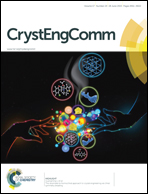Effect of ethylenediamine on the formation of macro, micro, and nanostructures based on [WVI(Cat)2O2]2−†‡
Abstract
We synthesized yellow needle-shaped crystals of (NH3CH2CH2NH3)0.5(NH3CH2CH2NH2)[(Cat)2WVI(O)2]·(NH2CH2CH2NH2), 1, with a one-dimensional chain-like quantum motif, and red bulk crystals of (NH3CH2CH2NH2)2[(Cat)2WVI(O)2], 2, with a multi-tubular quantum unit, by a slight change in the degree of protonation of ethylenediamine. By grinding and ultra-sonication, crystal 1 disintegrated into nanowires with diameters of about 18 nm and lengths of 300–1000 nm, and crystal 2 disassembled into nano-tubules with diameters of 15–18 nm and lengths of 450–550 nm. We found that the quantum motifs of the crystal lattices are a template of the nanostructures i.e. quantum-chains induced the formation of nanowires and quantum-tubules led to the production of nano-tubules. To investigate the mechanism by which such a delicate change of ethylenediamine can cause such a great transformation in the nanostructure, nano-pipe-bundles (rather than nanowires) prepared from crystal 3 were used as a comparison. Although crystals 3 and 1 have similar crystal parameters, they contain different ethylenediamine moieties i.e.3 is (NH3CH2CH2NH2)2[(Cat)2WVI(O)2]·(NH2CH2CH2NH2). As is well known, the electrostatic attraction of the doubly-protonated cation (NH3CH2CH2NH3)2+ to the anion [(Cat)2WVI(O)2]2− is stronger than that of the neutral molecule NH2CH2CH2NH2. The [(Cat)2WVI(O)2]2−-based chains were induced to split in various manners by different protonated ethylenediamines, thereby manufacturing different nano-architectures. This paper reveals that slight changes in the protonation of ethylenediamine can induce nanostructures assembled from [(Cat)2WVI(O)2]2− to form a variety of morphologies and sizes. We have proposed a new idea and method to prepare quite different tungsten organic hybrid nanostructures by changing the degree of protonation of ethylenediamine.
![Graphical abstract: Effect of ethylenediamine on the formation of macro, micro, and nanostructures based on [WVI(Cat)2O2]2−](/en/Image/Get?imageInfo.ImageType=GA&imageInfo.ImageIdentifier.ManuscriptID=C5CE00220F&imageInfo.ImageIdentifier.Year=2015)

 Please wait while we load your content...
Please wait while we load your content...